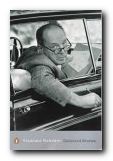a critical examination of Nabokov’s collected stories
 ‘Torpid Smoke’ (February 1935) brings the short story into the condition of what Clare Hanson has called ‘a form which mediates between the lyric poem and the novel’ (CH,p.9). The overt subject matter is reduced to no more than the protagonist’s dreamy reflections on the physical world around him and the joy he finds in poetic composition. In this sense it is not unlike one of the stories of ‘organised reflections’ by Katherine Mansfield or Virginia Woolf.
‘Torpid Smoke’ (February 1935) brings the short story into the condition of what Clare Hanson has called ‘a form which mediates between the lyric poem and the novel’ (CH,p.9). The overt subject matter is reduced to no more than the protagonist’s dreamy reflections on the physical world around him and the joy he finds in poetic composition. In this sense it is not unlike one of the stories of ‘organised reflections’ by Katherine Mansfield or Virginia Woolf.
One senses Nabokov gaining confidence about this time, perhaps spurred on by his success as a novelist. He seems to be making a clearer distinction between those effects possible in longer or shorter pieces of prose. Here the narrative element is played down, leaving poetic meditation and unity of tone and structure to do the work of holding the story together.
Grisha is a nineteen year old émigré relaxing after supper in the apartment where he lives with his father and sister. He is allowing himself to sink into a voluptuous languor of poetic image-making, which the third person narrative reflects by passing into the tones and rhythms of the prose poem, coming fairly close to the dissolution of meaning into ‘word music’:
‘an illusory perspective was formed, a remote mirage enchanting in its graphic transparency and isolation: a stretch of water, say, and a black promontory with the minuscule silhouette of an araucaria’ (RB,p.27).
This is Nabokov the writer in love with alliteration, verbal sonorities, and lexical delights: most readers are driven to a dictionary to discover that “araucaria” has more poetic possibilities than its more prosaic meaning of ‘monkey-puzzle tree’. But what might be seen as verbal self-indulgence can be justified here by its appropriateness to Grisha’s late-adolescent literary strivings. He is aware that his poems are ‘puerile [and] perishable’ (p.33) but he is enchanted by the process of composition itself.
He is also indulging a physical state of being which approximates to this mental state – one in which he feels that he is dissolving into the material world of which he is a part:
‘For example, the lane on the other side of the house might be his own arm, while the long skeletal cloud that stretched across the whole sky with a chill of stars in the east might be his backbone’ (p.29)
These elements of poetic meditation and the dissolution of the self into the everyday world are remarkably similar to the states of mind and being which Virginia Woolf had explored in her own short stories such as The Mark on the Wall and Reflections in a Looking Glass only a few years earlier.
In the midst of these reveries Grisha remembers seeing smoke on a rooftop earlier that day and feels a special sense of significance in it: ‘the chimney smoke hugged the roof, creeping low, heavy with damp, sated with it, sleepy, refusing to rise, refusing to detach itself from beloved decay’ (p.30). Of course the scene reflects his own state of being, but more than that he feels he feels what turns out to be the impulse towards a poetic recreation of his observation.
This process is interrupted by the only overt ‘action’ of the story. His sister asks him for some cigarettes. He gives them to her, sinks back into his horizontal repose, and the narrative passes into the first person to describe the thrill of composition: ‘a metrical line extended and bent; at the bend a rhyme was coming deliciously and hotly alight’ (p.33). It is a process which Grisha feels is the source of great pleasure – ‘this happiness is the greatest thing existing on earth’ (p.33).
There is almost no external eventfulness in the story at all. Following his predecessors Turgenev and Chekhov, Nabokov replaced overt causality as the subject of his story with that of the resolution of certain states of being, thus creating what is now seen by most commentators as the truly modern short story – one which Eileen Baldeshwiler calls ‘The Lyric Short Story’:
‘the locus of narrative art has moved from external action to internal states of mind, and the plot line will hereafter consist, in this mode, of tracing complex emotions to a closing cadence utterly unlike the reasoned resolution of the conventional cause-and-effect story. It is here that we observe the birth of the open story‘ (CM,p.206)
Although he has created a young and amateur writer as protagonist, the depiction of this creative exultation seems very convincing, especially since it accords with what one gathers from those other stories of Nabokov’s which deal with the relationship between art and life and this process of being creative. His next story from 1935 takes up this same there and adds to it a twist taken from his repertoire of concealed narrators.
© Roy Johnson 2005
![]() Vladimir Nabokov: The Collected Stories – Amazon UK
Vladimir Nabokov: The Collected Stories – Amazon UK
![]() Vladimir Nabokov: The Collected Stories – Amazon US
Vladimir Nabokov: The Collected Stories – Amazon US
Vladimir Nabokov web links
Vladimir Nabokov greatest works
Vladimir Nabokov criticism
Vladimir Nabokov life and works